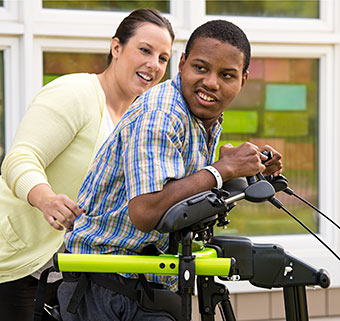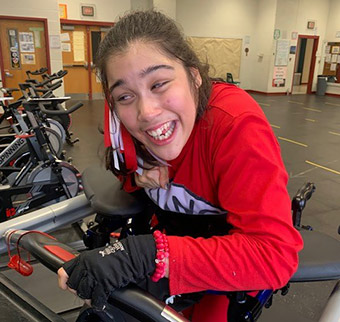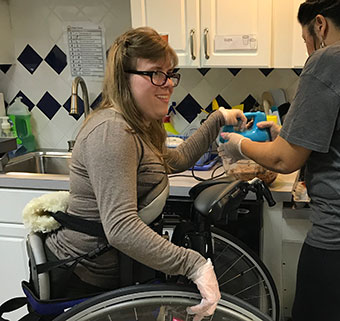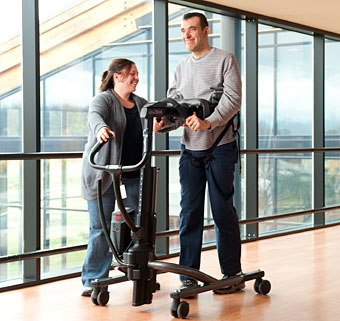Using Adaptive Equipment to Foster Participation in Vocational Settings
| August 2017 Physical therapists have long advocated for the use of standers and gait trainers to support the mobility, accessibility and health needs of youth and adults with mobility impairments including education of families/school teams and use of equipment in activity programs. Use of gait trainers, standers and other mobility devices allow individuals mobility they would not be able to achieve due to musculoskeletal impairments. Research demonstrates the important health benefits of such programs include increasing bone mineral density, physical activity and bowel/bladder function.1,2,3 As youth transition from school to post secondary experiences, theexpectation for employment arises.4 For some youth with physical disabilities, opportunities may be limited by mobility and ability to achieve a variety of body positions to access work tasks.
Physical therapists have long advocated for the use of standers and gait trainers to support the mobility, accessibility and health needs of youth and adults with mobility impairments including education of families/school teams and use of equipment in activity programs. Use of gait trainers, standers and other mobility devices allow individuals mobility they would not be able to achieve due to musculoskeletal impairments. Research demonstrates the important health benefits of such programs include increasing bone mineral density, physical activity and bowel/bladder function.1,2,3 As youth transition from school to post secondary experiences, theexpectation for employment arises.4 For some youth with physical disabilities, opportunities may be limited by mobility and ability to achieve a variety of body positions to access work tasks.
 As a school based physical therapist, I developed a program called “Fit4Work” that uses a Work Capacity Evaluation approach. This program is similar to a rehabilitative approach for injured workers, but focuses on examination and remediation of physical attributes necessary to participate in work activities.5 This work has focused on youth who use walking as their primary form of mobility.6 The Fit4Work concept can be expanded to youth with mobility impairments by considering the increased ability of an individual to perform an access and a task using standing/mobility devices to achieve the following:
As a school based physical therapist, I developed a program called “Fit4Work” that uses a Work Capacity Evaluation approach. This program is similar to a rehabilitative approach for injured workers, but focuses on examination and remediation of physical attributes necessary to participate in work activities.5 This work has focused on youth who use walking as their primary form of mobility.6 The Fit4Work concept can be expanded to youth with mobility impairments by considering the increased ability of an individual to perform an access and a task using standing/mobility devices to achieve the following:
a. Ability to reach overhead
b. Ability to reach low surfaces
c. Ability to move and carry items
d. Standing/walking endurance
If the individual uses a standing/mobility device in a Secondary setting, that device should be used to increase the individual’s mobility, accessibility to, and participation in their work setting. The table below describes the need for a position and related activities to perform specific vocational tasks.
|
Position Attained |
Need for Position |
Activity |
Vocational Task |
|
Reaching objects overhead, at standing height |
Some work tasks require the ability to reach high |
Put items on high shelves Restoring/moving items from waist level shelves |
Hang laundry, put items in washing machine, stocking snack machine |
|
Reaching objects at floor height |
Some work tasks require the ability to reach low |
Picking up objects from floor, stocking low shelves, moving items from shelves |
Put items in washing machine, stocking shelves |
|
Standing with tray |
Carrying objects
|
Moving objects in the work place |
Table top activities (sorting, crushing cans, paper work, organization tasks) |
 Use of standing and walking devices promotes physical activity which is known to enhance health.3,4,5 In a recent blog, Elena Noble discusses some of the societal barriers for young adults who are introduced to adaptive equipment after the age of 21, including lack of insurance reimbursement for equipment. The table below describes how physical therapists can advocate for equipment that fosters participation in vocational tasks.
Use of standing and walking devices promotes physical activity which is known to enhance health.3,4,5 In a recent blog, Elena Noble discusses some of the societal barriers for young adults who are introduced to adaptive equipment after the age of 21, including lack of insurance reimbursement for equipment. The table below describes how physical therapists can advocate for equipment that fosters participation in vocational tasks.
|
Access: |
Participation: |
Settings: |
Health: |
As physical therapists, when we determine that a student has an increased ability to engage in and participate in a task with the use of adaptive equipment, that device should be used across all settings, not just home and school. We, as physical therapists should promote the use of standers and gait trainers across all settings to increase participation in vocational tasks.
References:
- Glickman LB, Geigle PR, Paleg GS. A systematic review of supported standing programs. J Pediatr Rehabil Med. 2010;3(3):197-213. doi: 10.3233/PRM-2010-0129. PubMed PMID: 21791851.
- Paleg G, Livingstone R. Systematic review and clinical recommendations for dosage of supported home-based standing programs for adults with stroke, spinal cord injury and other neurological conditions. BMC Musculoskelet Disord. 2015 Nov 17;16:358. doi: 10.1186/s12891-015-0813-x. Review. PubMed PMID: 26576548; PubMed Central PMCID: PMC4650310.
- Paleg GS, Smith BA, Glickman LB. Systematic review and evidence-based clinical recommendations for dosing of pediatric supported standing programs. Pediatr Phys Ther. 2013 Fall;25(3):232-47. doi: 10.1097/PEP.0b013e318299d5e7. Review. PubMed PMID: 23797394.
- Doty, A., & Sylvester, L. Intervention for Youth Who Are in Transition from School to Adult Life. Retrieved September 17, 2016, from Academy of Pediatric Physical Therapy, http://pediatricapta.org/includes/fact-sheets/pdfs/Transition%20Fact%20Sheet.pdf.
- Johnson, C. (2016) Fit4work: Fitness for vocational tasks for youth with disabilities. United States: Createspace Independent Publishing Platform.
- Johnson CC, Rose DS. School-Based Work Capacity Evaluation in Young People With Intellectual Disabilities: 2 Case Reports. Pediatr Phys Ther. 2017 Apr;29(2):166-172. doi: 10.1097/PEP.0000000000000367. PubMed PMID: 28350776.





